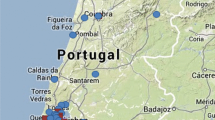Abstract
Inverse models can be used to estimate surface fluxes in terms of the observed atmospheric concentration measurement data. This paper proposes a new nonparametric spatio-temporal inverse model and provides the global expressions for the estimates by employing the B-spline method. The authors establish the asymptotic normality of the estimators under mild conditions. The authors also conduct numerical studies to evaluate the finite sample performance of the proposed methodologies. Finally, the authors apply the method to anthropogenic carbon dioxide (CO2) emission data from different provinces of Canada to illustrate the validity of the proposed techniques.
Similar content being viewed by others
References
Hoek G, Krishnan R M, Beelen R, et al., Long-term air pollution exposure and cardio-respiratory mortality: A review, Environmental Health, 2013, 12(1): 43.
Ji H, Wang J, Meng B, et al, Research on adaption to air pollution in chinese cities: Evidence from social media-based health sensing, Environmental Research, 2022, 210: 112762.
Phalen R F and Phalen R N, Introduction to Air Pollution Science, Bartlett Learning, Jones, 2011.
Miao Y, Porter W C, Schwabe K, et al., Evaluating health outcome metrics and their connections to air pollution and vulnerability in Southern California’s coachella valley, Science of the Total Environment, 2022, 921: 153255.
Byun D and Schere K L, Review of the governing equations, computational algorithms, and other components of the models-3 community multiscale air quality (CMAQ) modeling system, Applied Mechanics Reviews, 2006, 59(2): 51.
El-Harbawl M, Air quality modelling, simulation, and computational methods: A review, Environmental Reviews, 2013, 21(3): 149–179.
Fast J D, Gustafson W I, Easter R C, et al., Evolution of ozone, particulates, and aerosol direct forcing in an urban area using a new fully-coupled meteorology, chemistry, and aerosol model, Journal of Geophysical Research Atmospheres, 2006, 111: D21.
Zhu Y, Liang Y, and Chen S X, Assessing local emission for air pollution via data experiments, Atmospheric Environment, 2020, 252: 118323.
Bergamaschi P, Krol M, Dentener F, et al., Inverse modelling of national and European CH4emissions using the atmospheric zoom model TM5, Atmospheric Chemistry and Physics, 2005, 5(1): 2431–2460.
Bergamaschi P, Krol M, Meirink J F, et al., Inverse modeling of European CH4 emissions 2001–2006, Journal of Geophysical Research Atmospheres, 2010, 115: D22309.
Rigby M, Manning A J, and Prinn R G, Inversion of long-lived trace gas emissions using combined Eulerian and Lagrangian chemical transport models, Atmospheric Chemistry and Physics, 2011, 11(18): 9887–9898.
Zhao C, Andrews A E, Bianco L, et al., Atmospheric inverse estimates of methane emissions from Central California, Journal of Geophysical Research Atmospheres, 2009, 114: D16.
Jeong S, Zhao C, Andrews A E, et al., Seasonal variation of CH4 emissions from Central California, Journal of Geophysical Research Atmospheres, 2012, 117: D11.
Brioude J, Kim S W, Angevine W M, et al., Top-down estimate of anthropogenic emission inventories and their interannual variability in Houston using a mesoscale inverse modeling technique, Journal of Geophysical Research, 2011, 116(D20): D20305.
Brioude J, Petron G, Frost G J, et al., A new inversion method to calculate emission inventories without a prior at mesoscale: Application to the anthropogenic CO2 emission from Houston, Texas, Journal of Geophysical Research Atmospheres, 2012, 117(D5): 214–221.
Brioude J, Angevine W M, Ahmadov R, et al., Top-down estimate of surface flux in the Los Angeles Basin using a mesoscale inverse modeling technique: Assessing anthropogenic emissions of CO, NOx and CO2 and their impacts, Atmospheric Chemistry and Physics, 2013, 13(7): 3661–3677.
Miller S M, Wofsy S C, Michalak A M, et al., Anthropogenic emissions of methane in the United States, Proceedings of the National Academy of Sciences, 2013, 110(50): 20018–20022.
Bruhwiler L, Dlugokencky E, Masarie K, et al., Carbon Tracker-CH4, an assimilation system for estimating emissions of atmospheric methane, Atmospheric Chemistry and Physics, 2014, 14(2): 8269–8293.
Vogel F R, Ishizawa M, Chan E, et al., Regional non-CO2 greenhouse gas fluxes inferred from atmospheric measurements in Ontario, Canada, Journal of Integrative Environmental Sciences, 2012, 9(1): 41–55.
Chan E, Chan D, Ishizawa M, et al., Investigation of error sources in regional inverse estimates of greenhouse gas emissions in Canada, Atmospheric Chemistry and Physics, 2015, 15: 22715–22779.
Hallin M, Lu Z, and Tran L T, Local linear spatial regression, The Annals of Statistics, 2004, 32(6): 2469–2500.
Wang H, Wang J, and Huang B, Prediction for spatiotemporal models with autoregression in errors, Journal of Nonparametric Statistics, 2012, 24(1): 217–244.
Tang Q and Chen L, B-spline estimation for varying coefficient models with spatial data, Science China Series A, 2009, 52(11): 2321–2340.
Stone C J, Optimal global rates of convergence for nonparametric regression, The Annals of Statistics, 1982, 10(4): 1040–1053.
Schumaker L, Spline Functions: Basic Theory, 3rd Edition, Cambridge University Press, Cambridge, 2007.
Cressie N A C, Statistics for Spatial Data, Wiley, New Jersey, 1993.
Schwarz G, Estimating the dimension of a model, The Annals of Statistics, 1978, 6(2): 461–464.
Pace R K, Barry R, Gilley O W, et al., A method for spatial-temporal forecasting with an application to real estate price, International Journal of Forecasting, 2000, 16(2): 229–246.
Ibragimov I A and Linnik Y V, Independent and Stationary Sequences of Random Variables, Wolters-Noordhoff, Groningen, 1971.
Deo C M, A note on empirical process of strong mixing sequences, Annals of Statistics, 1973, 1(5): 870–875.
Wang H and Wang J, Estimation of the trend function for spatio-temporal models, Journal of Nonparametric Statistics, 2009, 21(5): 567–588.
Lu Z and Linton O, Local linear fitting under near epoch dependence, Econometric Theory, 2007, 23: 37–70.
Author information
Authors and Affiliations
Corresponding authors
Additional information
This research was supported by the National Social Science Fund of China under Grant No. 22BTJ021, “Qinglan project” of Colleges and Universities of Jiangsu Province and Postgraduate Research & Practice Innovation Program of Jiangsu Province under Grant No. KYCX21_1941.
Rights and permissions
About this article
Cite this article
Wang, H., Zhao, Z., Wu, Y. et al. B-Spline Method for Spatio-Temporal Inverse Model. J Syst Sci Complex 35, 2336–2360 (2022). https://doi.org/10.1007/s11424-022-1206-5
Received:
Revised:
Published:
Issue Date:
DOI: https://doi.org/10.1007/s11424-022-1206-5




